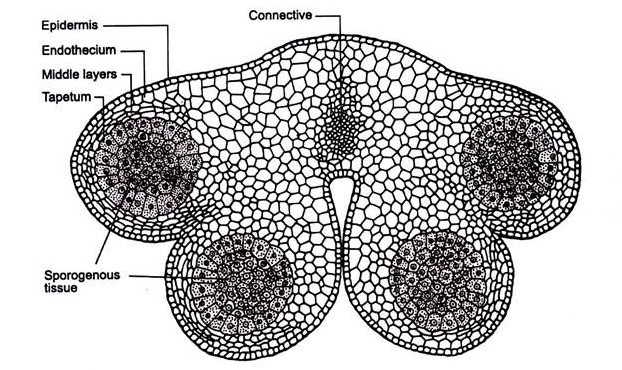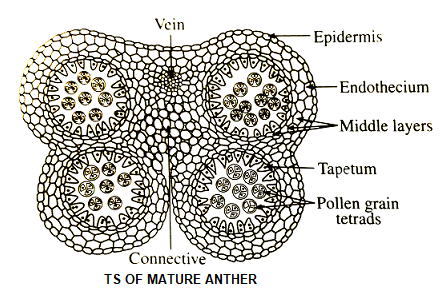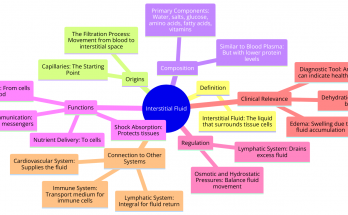Anther
The Anther is a part of a flowering plant’s stamen. It is the male reproductive structure. Anther is usually located at the tip of a filament and contains microsporangia which produces pollen. When the Anther matures it splits open to release the pollen which can then be transported to the female reproductive structure of the same plant or another plant of the same species resulting in fertilization and the production of seeds.
Diagram of Anther
Following are the diagrams of transverse sections of anthers in both the young and mature stage . Transverse section of anthers refers to a cross-sectional view of the anther taken perpendicular to its long axis i.e if you were to cut the anther horizontally, the resulting section would be a transverse section.
The transverse sections of young and mature anthers provide important information about the development and structure of anthers and pollen grains which helps in understanding the reproductive biology of flowering plants.
Also check – Sexual Reproduction in Flowering Plants
Table of Contents
Anther Diagram – Young Anther diagram – Transverse Section
Young Anther
Young Anther is the Anther structure when it is still developing and the microspore mother cells are undergoing meiosis to produce haploid microspores. At a young stage the anther is not fully developed and the pollen sacs are not filled with pollen grains.

Description of Anther diagram – Young Anther Transverse section – labels is as follows –
Epidermis
Epidermis is the outermost layer of cells that forms a protective covering over the anther. The epidermis is usually a single layer of flattened cells that are generally covered in a cuticle which helps to prevent water loss.
Endothecium
Endothecium is a layer of cells just beneath the epidermis that forms the outer layer of the anther wall. The endothecium is made up of several layers of cells that are thick-walled and contain lignin which provides strength to the anther.
Middle layers
Middle layers are the layer of cells located between the endothecium and the tapetum. The middle layers are usually composed of several layers of cells that can vary in size and shape. In some plants the middle layers play a role in supporting the anther.
Tapetum
Tapetum is a nutritive layer of cells that lines the inner surface of the anther wall and nourishes the developing microspores. Tapetum is typically a single layer of cells that produce and secrete various substances such as enzymes and nutrients . It supports the growth and development of the microspores.
Microsporangium or Pollen Sac
Four microsporangia or pollen sacs each containing microsporocytes (pollen mother cells) that undergo meiosis to produce haploid microspores.
Stomium
Stomium is the opening in the anther wall through which pollen is released.
Sporogenous tissue
Sporogenous tissue is the layer of cells within the anther that gives rise to the microspores. The sporogenous tissue is located within the pollen sacs . It consists of the microsporocytes or pollen mother cells. It undergoes meiosis to produce haploid microspores.
Also Check – Where does Mitosis and Meiosis occur ?
Connective tissue
A thin layer of cells that connects the anther to the filament. The connective tissue is usually composed of elongated cells that are arranged in a radial pattern and can play a role in supporting the anther.
Microspore mother cells (MMC)
Microspore mother cells (MMC) are the cells that undergo meiosis to produce haploid microspores.It will eventually develop into pollen grains.
Also Check – What is Double Fertilization ?
Anther Diagram – Mature Anther diagram – Transverse Section
Mature Anther
Mature Anther shows the structure of the anther at its final stage when the pollen grains are fully developed and ready for dispersal. At the mature stage the pollen sacs are filled with mature pollen grains and the anther is ready for pollination.

Description of Anther diagram – Mature Anther Transverse section – labels is as follows –
Epidermis
Epidermis is the outermost layer of cells that covers the surface of the anther.
Endothecium
Endothecium is a layer of cells located just beneath the epidermis that forms a protective sheath around the anther.
Middle layer
Middle layer is a layer of cells that sits between the endothecium and the tapetum.
Tapetum
Tapetum is a layer of cells that nourishes and supports the developing pollen grains.
Pollen sac
Pollen sacs are the two small compartments within each lobe of the anther where the pollen grains are produced and stored.
Septum
Septum is the wall that separates the two pollen sacs within each lobe of the anther.
Vascular bundle
Vascular bundle is a bundle of vessels that runs through the anther and provides nutrients to the developing pollen grains.
Connective tissue
Connective tissue is the tissue that connects the two lobes of the anther.
Pollen grain tetrads
Pollen grain tetrads are groups of four haploid cells that are produced after meiosis in the microspore mother cells. Pollen grain tetrads develop into individual pollen grains.
Also Check – “Pollination is Prerequisite for Fertilization in Flowering Plants” Explain

One Comment on “Anther Diagram”